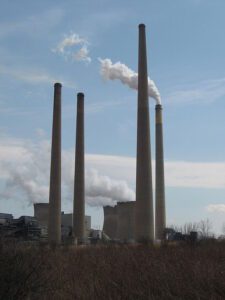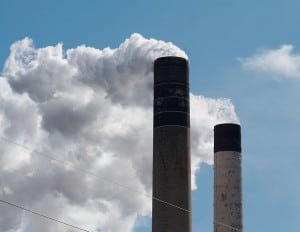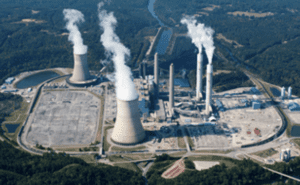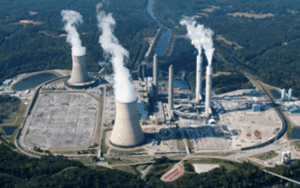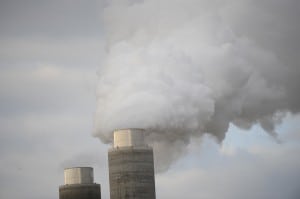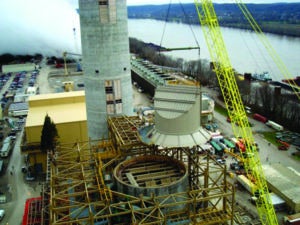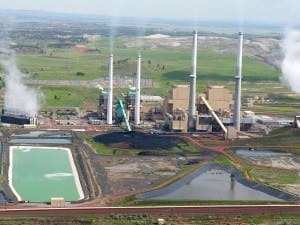Clean Air Act
-
Legal & Regulatory
EPA Streamlines Preconstruction Permitting to Accelerate Power Plants, Data Centers, and Manufacturing Reshoring
The U.S. Environmental Protection Agency (EPA) has issued new guidance under its New Source Review (NSR) preconstruction permitting program that could allow power plant developers to begin certain non-emissions‐related site work—such as installing concrete pads, grading, and utility trenching—before obtaining a Clean Air Act construction permit. The change, described in a sparse set of paragraphs […]
-
Trends
Delays, Rollbacks, and Diverging Paths: The Global State of Power Plant Emissions Controls
In recent years, analysis of the world’s power plant emissions appears to have centered largely on carbon dioxide (CO 2 ), mainly because carbon dominates global accounting frameworks and climate goals. In
-
Gas
Largest Pennsylvania Coal-Fired Plant Will Convert to Natural Gas
A major Pennsylvania coal-fired power plant, the largest coal-burning facility in the state before it was closed in 2023, may be converted to a natural gas-fired station. Officials in Homer City on Dec. 3 announced plans to restart the Homer City Generating Station and increase its generating capacity through burning natural gas. A redevelopment group […]
-
Legal & Regulatory
Federal Court Rejects Stay on EPA’s Carbon Pollution Standards in Setback for Power Industry
The U.S. Court of Appeals for the District of Columbia has denied motions to stay a suite of Environmental Protection Agency (EPA) regulations that champion carbon capture and storage (CCS) technology as a key pathway for reducing greenhouse gas emissions (GHGs) from fossil fuel-fired power plants. The rules face legal challenges from 24 states, eight […]
-
IIOT
GAO: EPA Relies on Outdated Systems to Manage Air Quality Data
Two IT air quality data systems that inform the U.S. Environmental Protection Agency’s (EPA’s) regulatory and compliance decisions are outdated, the U.S. Government Accountability Office (GAO) has suggested. The federal agency must make progress to develop a business case to replace them, it said. The congressional watchdog in a report made public on Sept. 29 […]
-
Legal & Regulatory
Expect Legal Challenges to New EPA Rules on Emissions
The U.S. Environmental Protection Agency (EPA) in May 2023 published a proposed rule that would establish new source performance standards (NSPS) and existing source performance standards (ESPS) for greenhouse gas (GHG) emissions from new, modified, reconstructed, and existing fossil-fuel fired electric generating units (EGUs). COMMENTARY The proposed rule, which EPA plans to promulgate pursuant to […]
-
Legal & Regulatory
Carbon Capture Key to EPA’s New Power Plant Emissions Rule
The U.S. Environmental Protection Agency (EPA) has unveiled new greenhouse gas (GHG) standards for the nation’s power plants, moving to require both existing and new facilities to capture emissions of carbon dioxide (CO2) for the first time. The rule announced May 11, if implemented, would mean coal- and natural gas-fired power plants would have to […]
-
Legal & Regulatory
Supreme Court Limits EPA Authority to Regulate Power Plant Emissions
The U.S. Supreme Court has curbed the Environmental Protection Agency’s (EPA’s) options for limiting emissions of greenhouse gases (GHG) from power plants, an important environmental decision that could impact the federal government’s authority to enforce other regulations. The court in a 6-3 vote, with conservatives in the majority, on June 30 said the EPA does […]
-
Legal & Regulatory
Montana District Court Vacates EPA’s ‘Secret Science’ Rule
The Environmental Protection Agency’s (EPA’s) “Secret Science” rule establishing new standards for consideration of certain “pivotal” scientific studies, which was slated to go into effect on Jan. 6 of this year, has been vacated and remanded by the U.S. District Court for the District of Montana. The decision reached Feb. 1 impacts the power generation […]
-
News
EPA Reinterprets ‘Ambient Air,’ Further Tweaks New Source Review
The Environmental Protection Agency (EPA) has finalized a change to a long-standing policy interpreting “ambient air”—a foundational concept under the Clean Air Act that applies to all types of air pollution, from ground-level ozone, particulate matter, and greenhouse gases. While the agency framed the change as part of a suite of actions to reform New Source […]
-
News
EPA’s Final Regional Haze Guidance Highlights State Discretion, Flexibility
New guidance issued by the Environmental Protection Agency (EPA) on Aug. 20 to help states prepare for the second implementation period of the federal regional haze program puts emphasis on “discretion and flexibilities” they can use to comply with long-standing mandates to protect visibility in federal areas. While it is not binding, the EPA’s […]
-
News
Clean Air Act Issues Congress Could Grapple With in New Session
While the Republican-led U.S. House and Senate in the 115th Congress was mainly focused on reviewing, for modification or repeal, several environmental rules issued under the Clean Air Act (CAA), the new Democrat majority in the House could focus on a slew of different measures, a new report from the Congressional Research Service (CRS) suggests. […]
-
Environmental
The Impact of Environmental Regulations on Power Generation
For many years, air pollution control (APC) rules and regulations have governed the design and economics of the world’s power generation fleet. These rules have had a tremendous impact, improving air quality
-
Legal & Regulatory
New York Gas Plant Comes Online Despite Opposition
The Valley Energy Center in Orange County, New York, entered commercial operation on October 1 despite complaints from local officials and area residents about noise from the plant, among other concerns. Community members spoke out against the plant at public hearings last week, saying they have felt sick when the plant has undergone test runs […]
-
Legal & Regulatory
Trump Emissions Plan Aims to Boost Coal-Fired Power
The Trump administration has proposed an overhaul of U.S. power plant emissions rules, unveiling a plan that would allow individual states to determine how they will regulate pollutants. The proposal, called the Affordable Clean Energy (ACE) plan and discussed during the keynote address at the MEGA Symposium in Baltimore, Maryland, on August 21, would essentially dissolve […]
-
Legal & Regulatory
EPA Seeks Input on Potential Clean Power Plan Replacement
The Environmental Protection Agency (EPA) is considering drafting a replacement of the Obama administration’s Clean Power Plan. The agency on December 18 published an Advance Notice of Proposed Rulemaking (ANPRM) soliciting comments from the public on how the replacement should look. The ANPRM is separate from the agency’s current effort to repeal the current rule. […]
-
Coal
Operator Reverses Course, Will Keep Running Montana Coal Plant
The operator of one of the largest coal-fired power plants in the Western U.S. will continue to run the facility, changing course about a year after a company executive said the plant was not economically viable. A spokesman for Talen Energy confirmed to POWER on August 9 that the company will continue to operate the […]
-
Legal & Regulatory
Northeastern States File Suit to Force EPA Action on Ozone Transport Region Expansion
Six northeastern states are suing the Environmental Protection Agency (EPA) to force it to act on controlling air pollution blowing in from coal-fired power plants located in nine Midwestern and southern states. New York, Connecticut, Massachusetts, New Hampshire, Rhode Island, and Vermont on October 7 filed a lawsuit in the U.S. District Court for the […]
-
Commentary
Learning from the Clean Air Act’s Tragic Flaw
“Why are you picking on the Clean Air Act?” That’s a question we’ve heard more than once while traveling the country to talk about our new book, Struggling for Air: Power Plants and the “War on
-
Legal & Regulatory
Air Emissions Tampering Leads to Felony Charges at Power Plant
The owner and management company of the Berkshire Power Plant—a 252-MW natural gas–fired combined cycle plant located in Agawam, Mass.—agreed to plead guilty on March 30 to felony charges that the companies violated and conspired to violate the federal Clean Air Act. The indictments against Berkshire Power Co. (BPC), the owner of the plant, and […]
-
Coal
Duke Energy to Shutter Three Coal Units, Resolve Drawn-Out Clean Air Act Lawsuit
Duke Energy has settled a 15-year-old lawsuit for allegedly violating the Clean Air Act when it made modifications at 13 coal-fired power units in North Carolina. The Environmental Protection Agency’s (EPA’s) and the Department of Justice’s (DOJ’s) original case filed in 2000 focused on 25 Duke Energy coal units. As it has in more than […]
-
Commentary
Get Ready for MATS 2.0
On June 29, much of the power sector rejoiced when the U.S. Supreme Court struck down the Environmental Protection Agency’s (EPA’s) Mercury and Air Toxics Standards (MATS) rule, finding that the EPA had
-
Renewables
IPL to Retire or Repower Coal Units in Iowa Under PSD Settlement With Feds
Interstate Power and Light (IPL) will be forced to spend $620 million to retire 10 coal-fired units and retire, refuel, or install pollution controls at several others in Iowa under a settlement reached with the federal government. The Alliant Energy subsidiary has long anticipated the settlement announced on July 15 by the Environmental Protection Agency […]
-
Legal & Regulatory
Federal Court Strikes Challenge to Proposed EPA Carbon Rule as Premature
The D.C. Circuit rejected challenges to the Environmental Protection Agency’s (EPA’s) proposed carbon rules for existing power plants, ruling that it has no authority to review rules that aren’t yet final. “Petitioners are champing at the bit to challenge EPA’s anticipated rule restricting carbon dioxide emissions from existing power plants. But EPA has not yet […]
-
Legal & Regulatory
Proposed Ozone Rule May Be the Most Costly Regulation Ever
Estimates vary widely, but even the Environmental Protection Agency acknowledges that lowering the ozone standard will cost billions. How will it affect power companies? It could make approval of new projects much more difficult. Even in the annals of expensive environmental regulations and the hyperbole that often accompanies them, the numbers are eye-popping: $140 billion […]
-
Coal
Experts: EPA Clean Power Plan’s Legal Uncertainty May Have Lasting Impact
The Environmental Protection Agency’s (EPA’s) Clean Power Plan will certainly be challenged in court, but states and power companies must expend enormous resources developing and complying with state plans regardless of the outcome, witnesses testified on March 17 at a House hearing on the proposal’s legal and cost issues. The three-hour-long hearing at the House […]
-
Legal & Regulatory
A U.S. Power Industry Regulatory Update
The U.S. power sector has seen a number of developments on the regulatory front in recent months. Here’s where major federal rules stand today. (For a more dynamic and graphic version of this article, see http://powermag.com/long-form-stories/bw-power/ .) GHG Rules New Power Plants. The Environmental Protection Agency (EPA) in September 2013 revised a 2012 proposal to […]
-
Coal
DOJ Files to Enforce Luminant’s Alleged NSR Violations at Big Brown, Martin Lake
An enforcement action filed in federal district court by the Department of Justice last week alleges Luminant Generating Co. made unauthorized changes to its Big Brown and Martin Lake coal-fired power plants in Texas that violated the Clean Air Act. The case filed under seal in the Northern District of Texas (Dallas division) follows a […]



